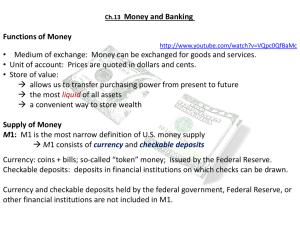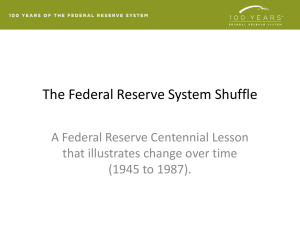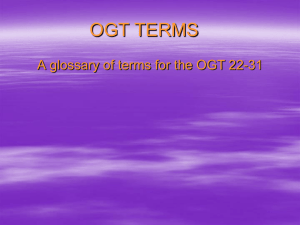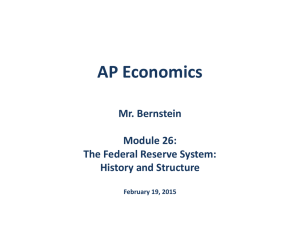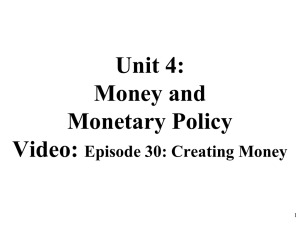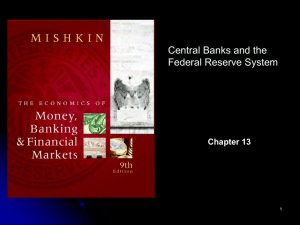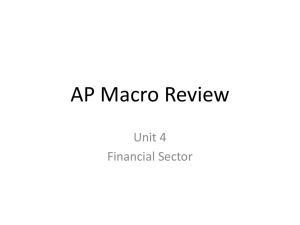The Federal Reserve (1913)
advertisement
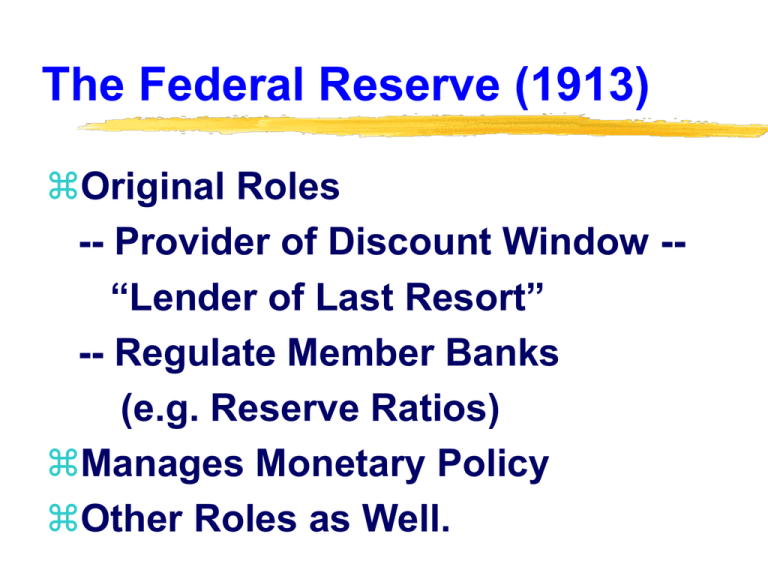
The Federal Reserve (1913) Original Roles -- Provider of Discount Window -“Lender of Last Resort” -- Regulate Member Banks (e.g. Reserve Ratios) Manages Monetary Policy Other Roles as Well. Structure of the Federal Reserve Board of Governors (BOG) 7 members appointed by the President, with the consent of the Senate serves 14 year, non-renewable terms sets policy instruments other than open market operations decides permissible activities of banks and bank holding companies Important Chairs of the BOG (Federal Reserve) Paul Volcker -- 1979-87 Alan Greenspan -- 1987-2006 Ben Bernanke -- 2006- The Federal Open Market Committee (FOMC) 12 voting members -- 7 Board of Governors + 5 District Bank Presidents (19 members in all) meet 8 times per year (more, if needed) designs monetary policy, by specifying Federal Funds rate target (since 1988) announces meeting results – assessment of economy and policy moves – to public immediately after meeting Federal Reserve District Banks each bank exists within 12 districts within the US holds deposits of Federal Government collects economic data and does economic research issues and discards currency performs check clearing services District Banks -Administer Monetary Policy conduct Discount Loans with banks within district enforce reserve requirements for banks within district hold reserves of banks within district New York bank most important, open market operations done there Federal Reserve Branch Banks and Member Banks Branch (District) Banks -- serve as decentralized regulators, primarily for larger Fed districts in geographic size Private Banks -- membership distinction trivialized by DIDMCA How Independent is The Federal Reserve? Structure implies considerable independence. Federal Reserve is financially independent of the Federal Government’s budget. Federal Reserve is still subject to Congressional legislation. -- Dodd-Frank Act – increased oversight of Federal Reserve activities by the Federal Government. -- The Big Threat: legislation calling for significant changes in Fed structure (including placing it directly under the authority of the President and/or Congress). The President and the Federal Reserve -- President appoints members of the BOG -- BOG typically serve less than 14 year terms -- part of the legislative process, can introduce legislation Federal Reserve has vigorous lobby in Congress. -- banks: stability of banking system -- financial markets: low inflation, stability -- international presence Explaining Federal Reserve Behavior Theory of Bureaucratic Behavior -- The objective of a bureaucracy is to maximize its own welfare. Applied to the Federal Reserve -- The Fed seeks to maximize its power and autonomy (at the possible expense of economic welfare). Evidence: The Fed and The Theory of Bureaucratic Behavior Fed tends to avoid conflict with Congress. Fed rarely admits policy errors. Fed tends to support legislation that increases its authority (DIDMCA, FDICIA) and does not decrease its authority. Should the Federal Reserve Remain Independent? Arguments to Remove Independence Current Federal Reserve is not democratic, not accountable. Fed has made policy mistakes. Potential for uncoordinated fiscal and monetary policies Example -- expansionary fiscal policy with contractionary monetary policy Interest rates Fed can increase liquidity to almost unlimited amounts by constantly printing money. Arguments to Maintain Independence If part of the Federal Government, the Federal Reserve could be used to purchase all of the Federal deficit and debt (“monetizing the debt), highly inflationary. Federal Reserve is more knowledgeable and focused on the economy than Congress. The Biggest Argument For Continued Independence Current Federal Reserve can make the tough policy decisions. The track record of the US Federal Reserve: strong domestic economy in the Volcker and Greenspan years, agility in handling of financial crisis by Bernanke.


